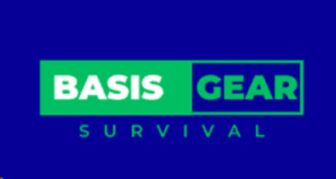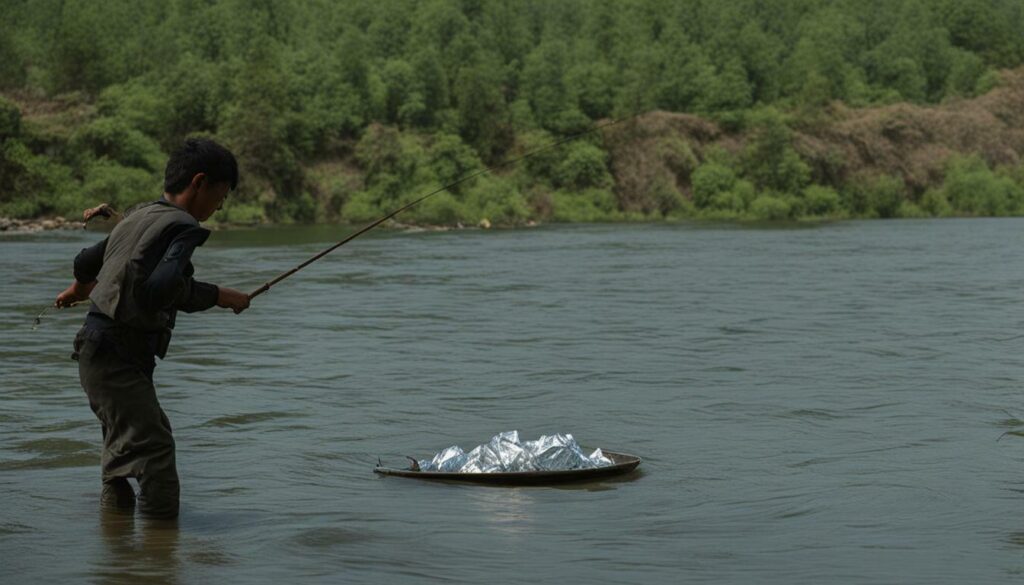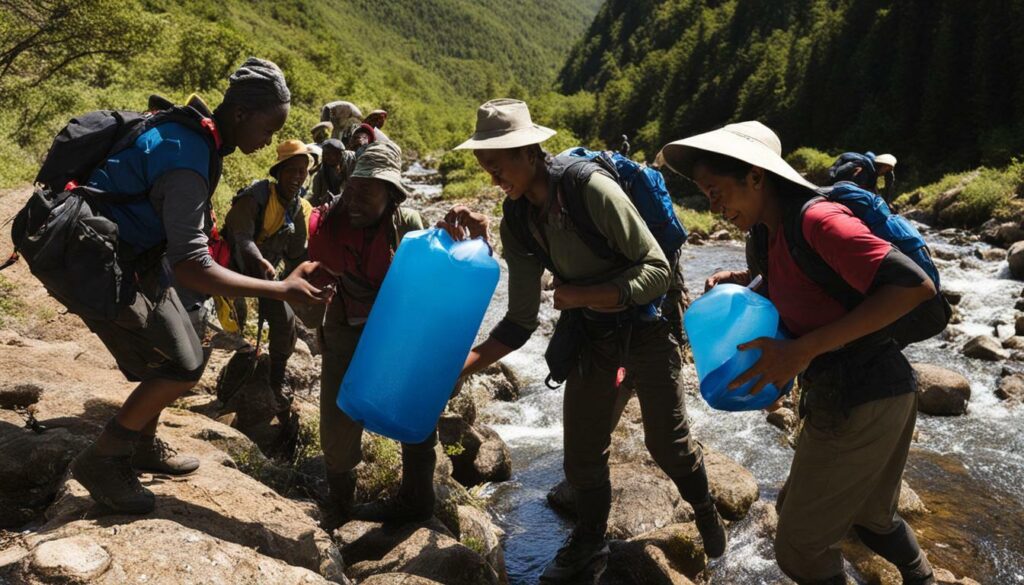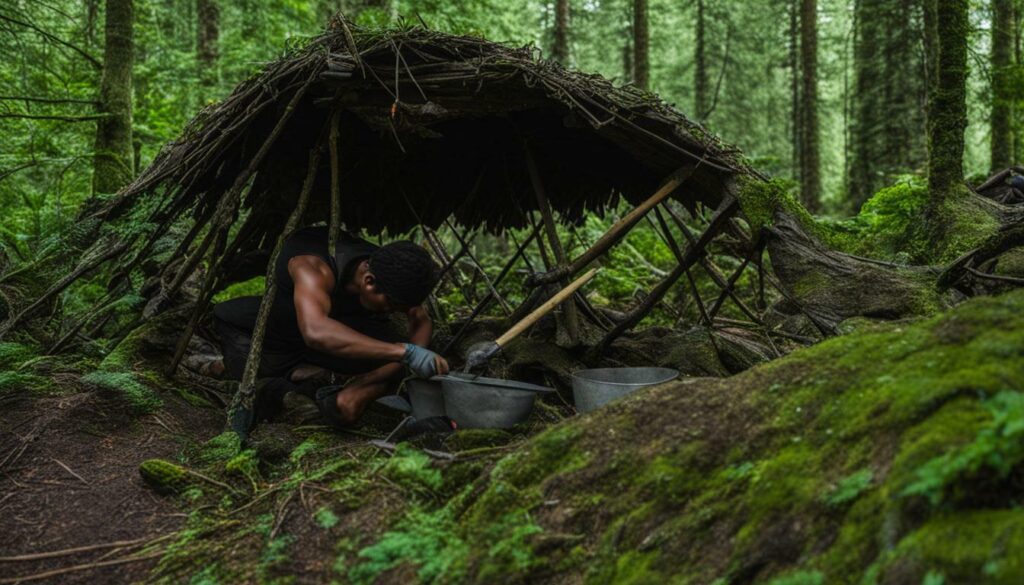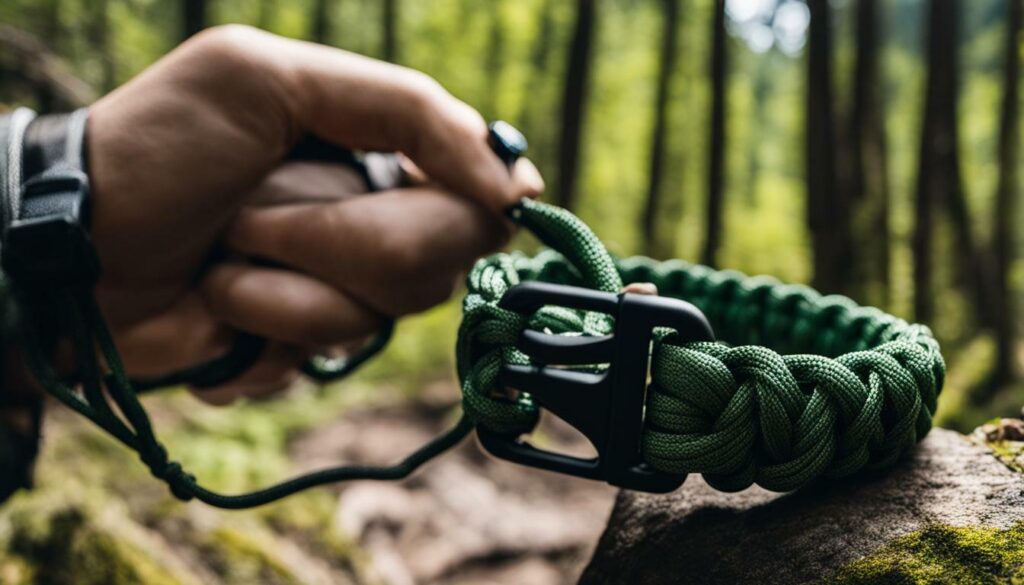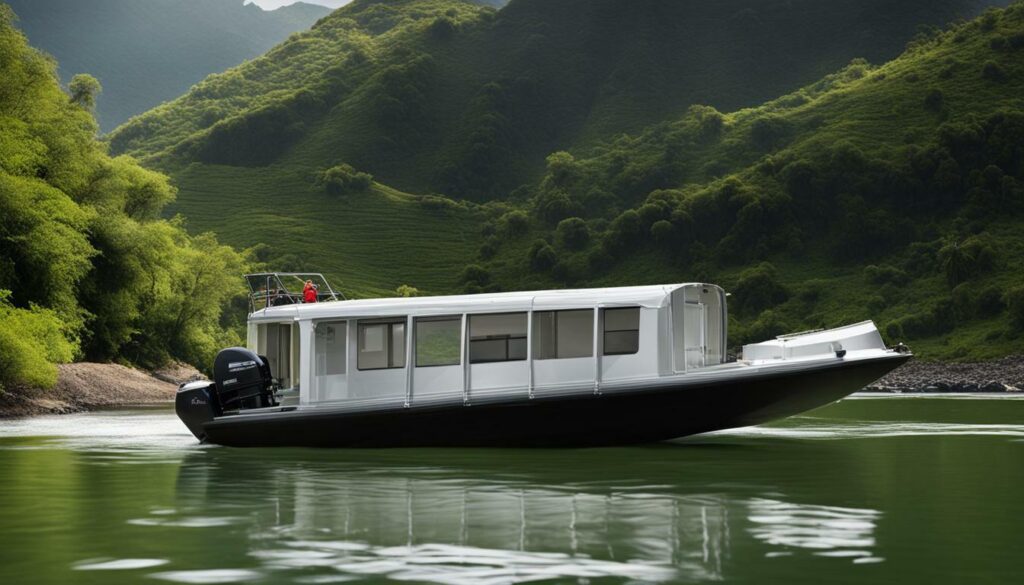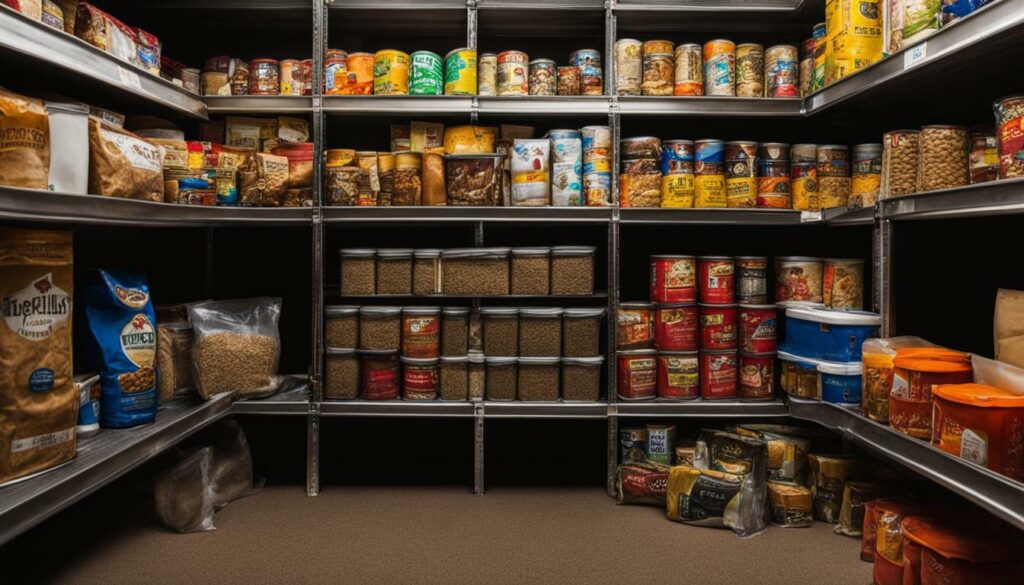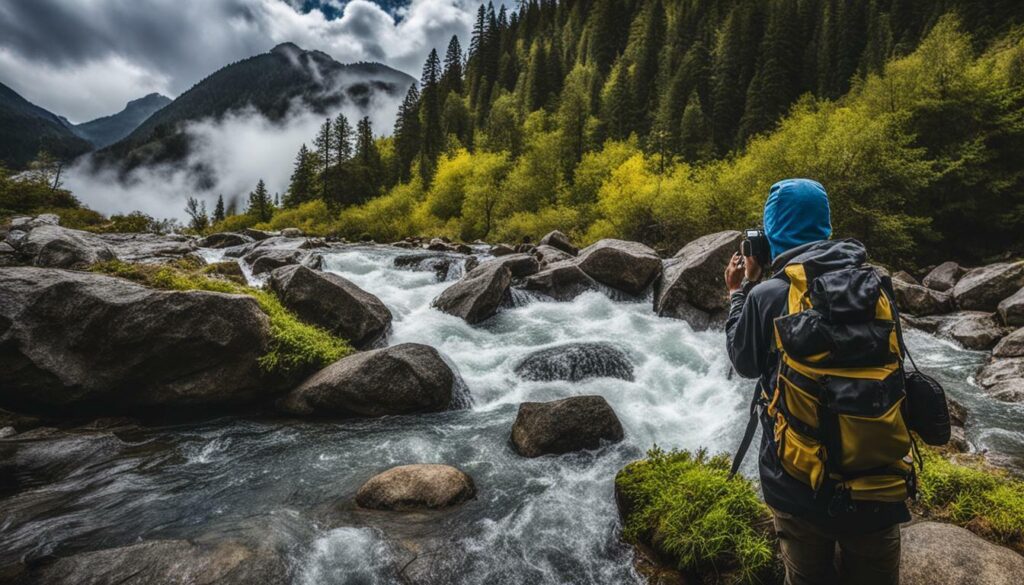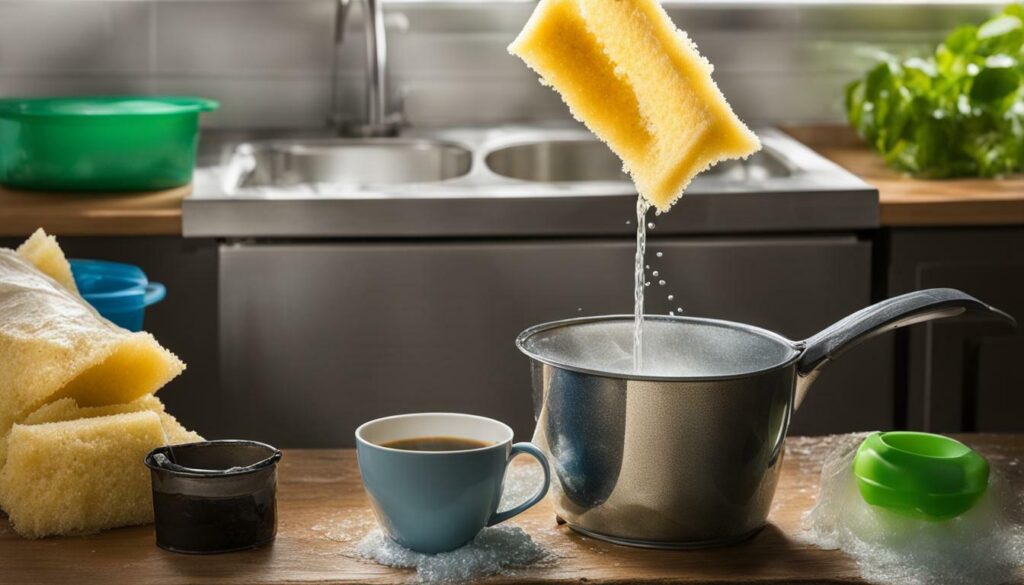

In today’s world, being prepared for any survival situation is crucial, and you may be surprised to learn that everyday household items can double as life-saving gear. From shoelaces to chewing gum, there are a wide variety of items that can serve as substitutes for traditional survival gear. These household items not only provide practical solutions in emergency situations but also offer a cost-effective alternative to expensive gear.
Key Takeaways:
- Shoelaces can be repurposed as a splint, fishing line, shelter, and firestarter.
- Chewing gum can help ward off hunger, act as bait, and be used as a firestarter.
- Bleach can be used to purify water and sanitize surfaces.
- Soda can provide a quick energy boost, be used for fishing, and even act as a cooking pot.
- Hand sanitizer can serve as a cleaning agent and firestarter.
These are just a few examples of how household items can be utilized in survival situations. By exploring the versatility of these items, you can add an extra layer of preparedness to your emergency plans. Remember, it is crucial to have an emergency kit stocked with essential items such as water, food, a radio, flashlight, and a first aid kit. Additionally, consider personalizing the kit based on individual needs, such as prescriptions, pet supplies, and important documents. Regularly maintain the kit and have multiple storage locations, including home, work, and car.
Essential Household Items for Emergency Preparedness
When it comes to emergency preparedness, having the right household items can make all the difference. Here are some essential items to consider for your emergency kit.
| Item | Uses |
|---|---|
| Shoelaces | Can be used for various purposes such as making a splint, fishing line, shelter, and even starting a fire. |
| Chewing gum | Can help ward off hunger and be used as bait or a firestarter. |
| Bleach | Can purify water and sanitize surfaces. |
| Soda | Can provide a quick energy boost, be used for fishing, and as a cooking pot. |
| Hand sanitizer | Can be used for cleaning and starting fires. |
| Tampons | Can be used as wound dressings and to collect water. |
| Black trash bag | Can be used for various purposes such as carrying supplies, shelter, and collecting water. |
It is important to have an emergency kit stocked with these essential items. In addition to the items listed above, consider including water, food, a radio, flashlight, first aid kit, and more based on your individual needs. Personalize your emergency kit by including any necessary prescriptions, pet supplies, and important documents. Regularly maintain your kit and have multiple storage locations, including home, work, and car, to ensure preparedness in any situation.
Image:
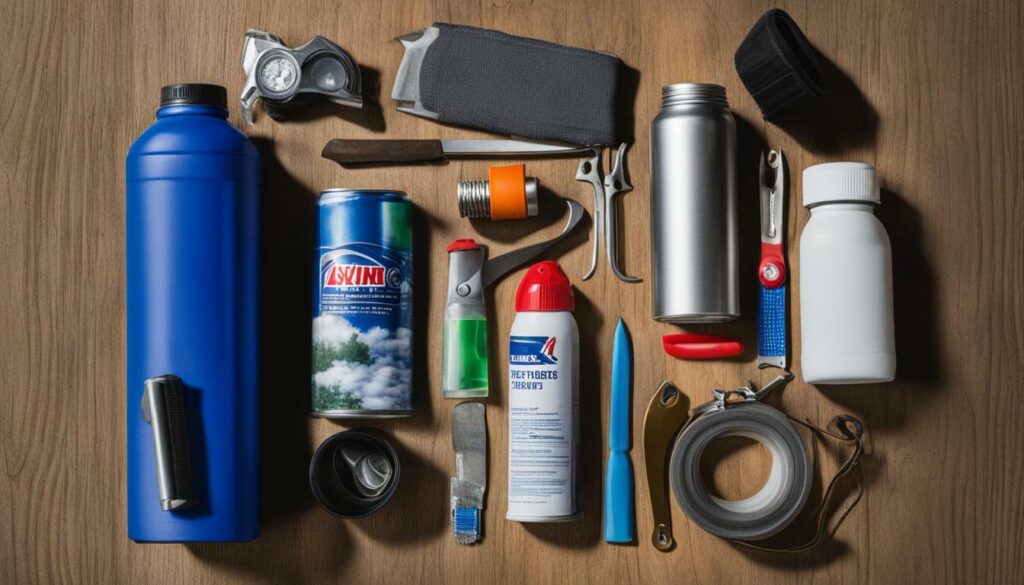

Remember, having the right household items can provide practical alternatives to traditional survival gear. Stay prepared and ensure the safety of yourself and your loved ones with these essential household items for emergency preparedness.
Shoelaces: More than Just Footwear Accessories
Don’t underestimate the power of a simple shoelace – it can be the ultimate survival tool in unexpected situations. Shoelaces are versatile and can be repurposed in numerous ways, making them an essential household item for any survival kit.
“A shoelace can be used as a makeshift fishing line to catch food in a survival situation. Simply tie a hook to one end and attach a small weight to the other. It’s a great hack for when you don’t have traditional fishing gear.”
Shoelaces can also be used to create a shelter. By tying them together and securing them to sturdy branches or trees, you can construct a basic tent or lean-to. This can provide protection from the elements and create a safe space to rest.
In addition to shelter and food, shoelaces can also be used as a tool to start a fire. By unraveling the lace and creating a friction-based movement, you can generate enough heat to ignite a flame. This can be especially useful when you need warmth or a way to signal for help.
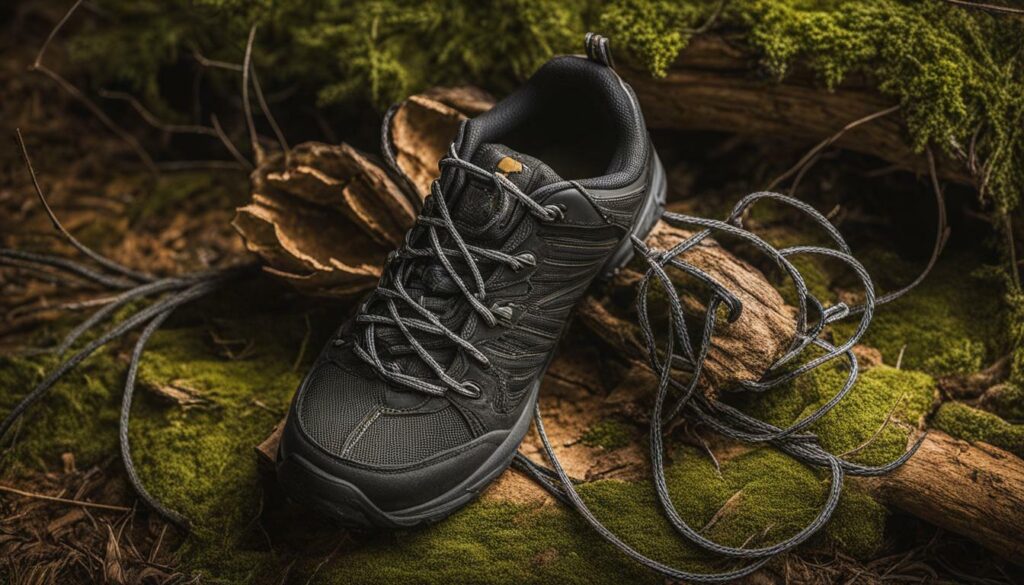

| Survival Hack | Shoelace Use |
|---|---|
| Creating a makeshift splint | Tying a shoelace tightly around a broken limb to immobilize it |
| Emergency fishing line | Attaching a hook and weight to a shoelace to catch fish |
| Building a shelter | Tying shoelaces together to secure a tarp or poncho for protection |
| Starting a fire | Creating friction with unraveled shoelace to ignite a flame |
Next time you lace up your shoes, remember the hidden potential of a humble shoelace. It can be a lifesaver in survival situations, proving that everyday household items can double as essential tools when the unexpected happens.
Chewing Gum: A Surprising Survival Tool
While chewing gum is often seen as just a tasty treat, it can actually be a vital tool in survival scenarios. Its versatility makes it a valuable addition to any emergency preparedness kit. Here are some surprising ways chewing gum can be used as a survival tool:
- Ward off Hunger: In a survival situation, finding food may be a challenge. Chewing gum can help suppress hunger, providing a temporary solution until more substantial food sources are available.
- Bait and Firestarter: Chewing gum can be used as bait for trapping small animals when fishing or hunting. Additionally, its flammable properties make it suitable for starting fires, especially when combined with other fire-starting materials such as cotton and candle wax.
By utilizing chewing gum in these ways, you are essentially turning it into a multi-purpose survival tool. Its compact size and long shelf life make it ideal for inclusion in any emergency kit.
Remember, while these survival hacks can be helpful, it is essential to have a properly stocked emergency kit that includes a wide range of essential items. Water, food, a radio, flashlight, first aid kit, and other crucial supplies should be prioritized. Additionally, consider personalizing your kit based on individual needs, such as medication, pet supplies, and important documents. Regularly maintaining your emergency kit and having multiple storage locations, including home, work, and car, will ensure you are always prepared for any emergency situation that may arise.
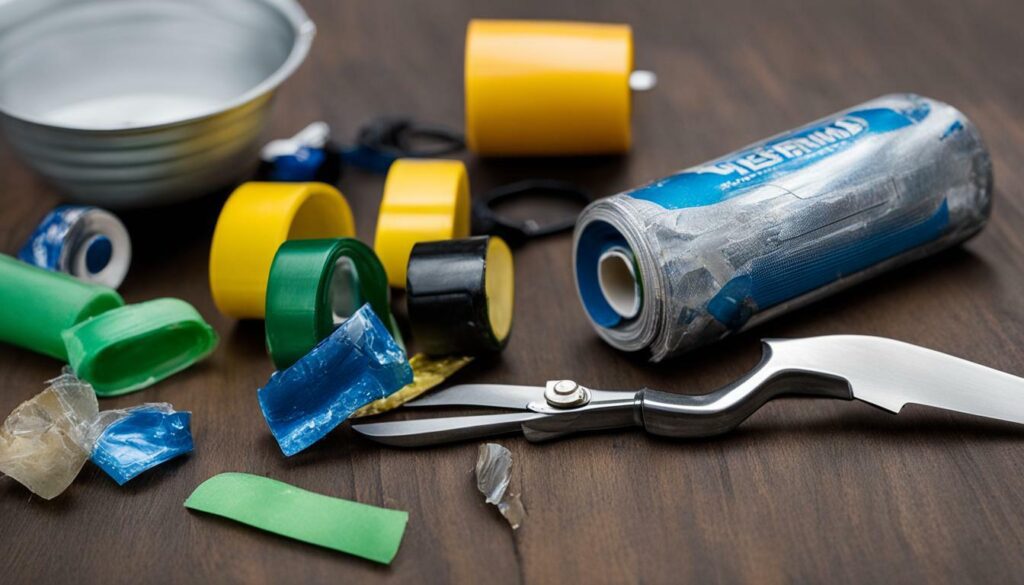

Bleach: Purify Water, Sanitize Surfaces
When it comes to cleanliness and water safety during emergencies, bleach can be a true lifesaver. Not only can it purify water, but it can also help sanitize surfaces, preventing the spread of diseases. In survival situations where access to clean water is limited, bleach can be used as an effective method to make water safe for consumption. To purify water using bleach, follow these steps:
- Filter the water to remove any visible particles or debris.
- Add 1/8 teaspoon of unscented bleach for every gallon of water (or 8 drops for every gallon).
- Mix well and let the water stand for at least 30 minutes before drinking.
It is important to note that bleach should only be used in small quantities and not as a long-term solution. Additionally, make sure to use unscented bleach, as scented varieties may contain additional chemicals that are unsafe for consumption.
Bleach also serves as a powerful tool for sanitizing surfaces in emergency situations. Simply mix 1 part bleach with 9 parts water and use the solution to clean and disinfect various surfaces, including countertops, utensils, and even wounds. This can help prevent the spread of bacteria and viruses, ensuring a safer environment in challenging circumstances.
Table: Dilution Ratio for Bleach Solution
| Bleach | Water |
|---|---|
| 1 cup | 9 cups |
| 1/2 cup | 4 1/2 cups |
| 1/4 cup | 2 1/4 cups |
| 1 tablespoon | 9 tablespoons |
Household bleach, when used correctly, can be a valuable asset in emergency preparedness. It offers a simple and accessible solution for purifying water and sanitizing surfaces, ensuring the safety and well-being of individuals in survival situations.
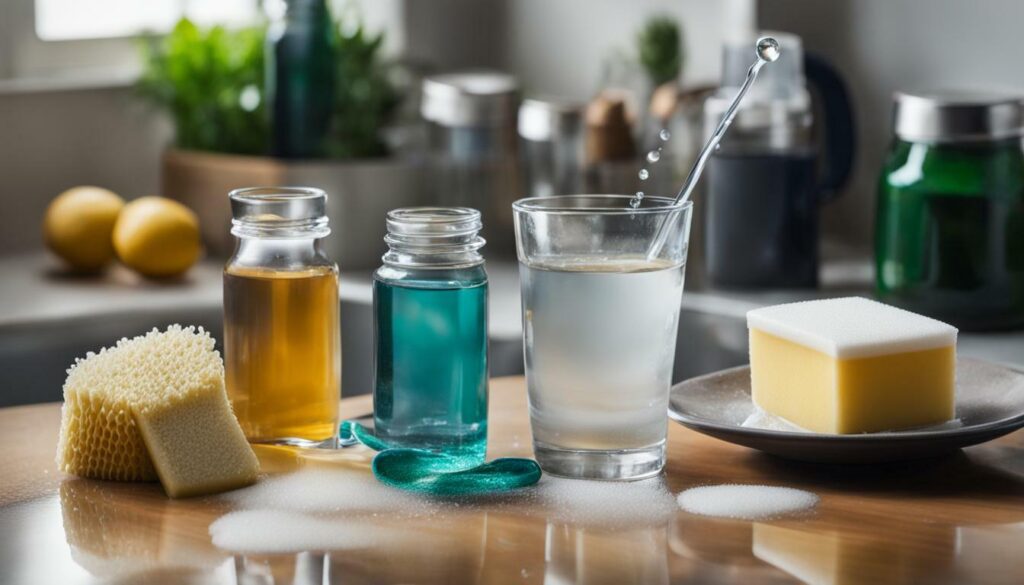

Your favorite soda can do much more than quench your thirst – it can be a valuable resource in survival scenarios. Whether you find yourself in the wilderness or facing a natural disaster, soda can provide you with the versatility you need to survive. Here are some surprising ways soda can be used as a survival tool:
- Quick Energy Boost: The high sugar content in soda can provide a quick burst of energy when needed. In emergency situations, where food may be limited, a can of soda can help keep you going.
- Fishing: Did you know that soda can be used as bait? The sweet scent and bright color of soda can attract fish, making it a handy substitute for traditional bait. Simply pour some soda into a container and place it near your fishing spot.
- Cooking Pot: In a survival situation, finding a way to cook food can be a challenge. Soda cans can be repurposed as makeshift cooking pots. With some creativity, you can use them to boil water or cook simple meals.
Remember to always prioritize safety in survival situations and use soda as a last resort when other options are unavailable. While soda can be a valuable resource, it should not replace proper survival gear.
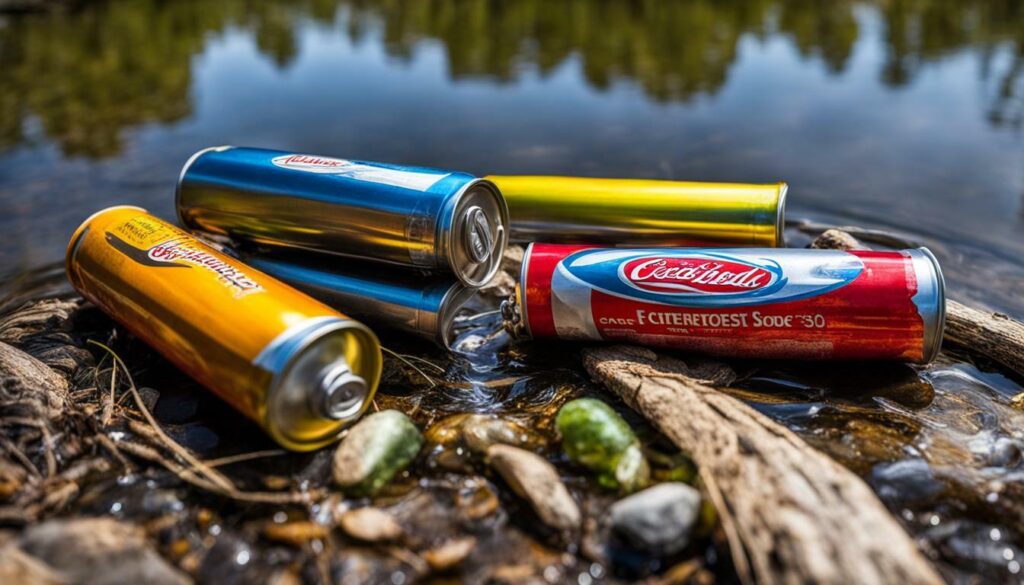

A complete guide to converting soda cans into survival tools can be found in the table below:
| Soda Can Survival Tool | Usage |
|---|---|
| Fishing Lure | Use the empty soda can as a shiny fishing lure to attract fish. |
| Cooking Pot | Remove the top of the soda can and use it as a small cooking pot. |
| Signal Mirror | Polish the bottom of the soda can to create a reflective surface for signaling rescuers. |
| Water Filter | Punch small holes in the bottom of the soda can, fill it with layers of charcoal, sand, and gravel, and use it as a makeshift water filter. |
| Container | Cut open the soda can to create a small container for storing food or water. |
Stay Prepared with Soda
In conclusion, soda can be an unexpected ally in survival situations. Its versatility as both a source of energy and a makeshift tool makes it a valuable addition to any emergency kit. It is important to always have a well-stocked emergency kit, including essential items like water, food, a radio, flashlight, and a first aid kit. Additionally, consider personalizing the kit based on individual needs, such as prescription medications, pet supplies, and important documents. Regularly maintain your emergency kit and have multiple storage locations, such as home, work, and your car, to ensure you are prepared for any situation.
Hand Sanitizer: Cleanliness and Firestarter in One
Hand sanitizer is not only useful for keeping germs at bay; it can also be a versatile tool in survival scenarios. In addition to its primary purpose of disinfection, hand sanitizer can serve as an essential item in your arsenal of household items doubling as survival tools. Let’s explore some of the ways hand sanitizer can be a valuable resource in emergency situations.
Firstly, hand sanitizer can be used as a firestarter. Its high alcohol content makes it highly flammable, allowing it to ignite easily. When in need of a fire, simply squeeze a small amount of hand sanitizer onto dry kindling or paper and use a match or lighter to ignite it. This can be especially handy when traditional firestarting materials are not readily available.
Moreover, hand sanitizer can be used for cleaning purposes in survival situations. When access to clean water and soap is limited, hand sanitizer can help keep your hands and surfaces clean. Its powerful disinfecting properties can help eliminate harmful bacteria and viruses, reducing the risk of infection. Remember to apply a generous amount of hand sanitizer to cover your hands thoroughly and rub them together until dry.
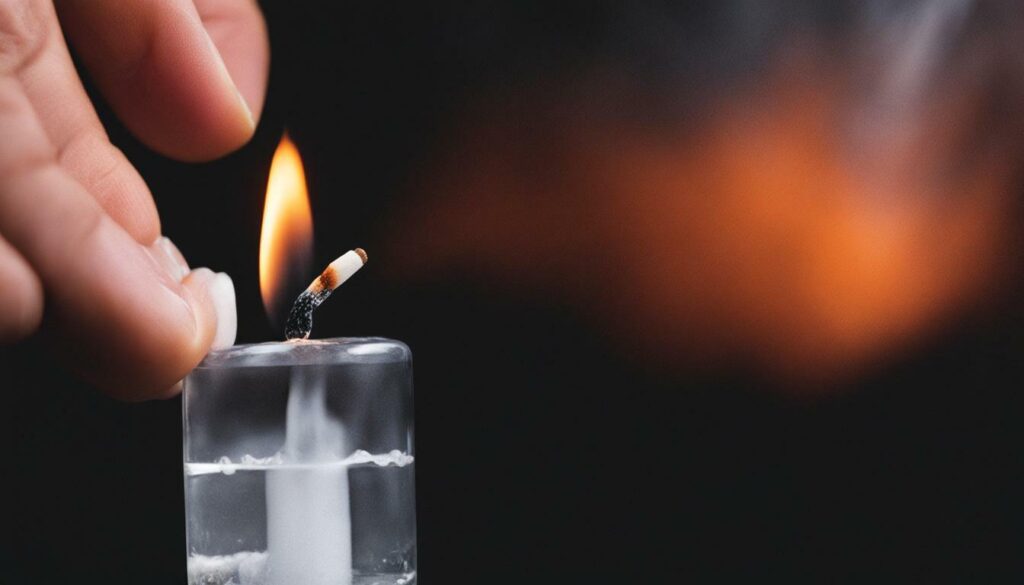

In conclusion, hand sanitizer is more than just a germ-fighting solution; it is a valuable tool in survival scenarios. Whether you need to start a fire or maintain cleanliness, hand sanitizer can be a practical and versatile resource. In your emergency kit, be sure to include a bottle of hand sanitizer to ensure you are prepared for any situation that may arise.
Tampons: Versatile Survival Tools
Tampons, often associated with feminine hygiene, can actually be a valuable survival tool for both men and women. In emergency situations where access to medical supplies is limited, tampons can serve multiple purposes. Their compact size and absorbent capabilities make them a practical addition to any survival kit.
Wound Dressings and Water Collection
One of the key uses for tampons in survival situations is as wound dressings. The absorbent material can help stop bleeding and protect wounds from infection. Tampons can be inserted into deep wounds or used to apply pressure to control bleeding.
Additionally, tampons can be used to collect water. When soaked in water, they can absorb and store a considerable amount of liquid. This can be especially useful in situations where clean drinking water is scarce or contaminated. By using tampons as a makeshift filter, you can collect and purify water, ensuring your hydration needs are met.
Table: Additional Uses of Tampons in Survival Situations
| Use | Description |
|---|---|
| Fire Tinder | The cotton material in tampons can be unraveled and used as excellent fire tinder. When combined with a firestarter, it can help ignite a fire quickly and easily. |
| Insulation | Tampons can be used as insulation in clothing or as padding for blisters and hot spots on your feet. |
| Emergency Candle | By saturating the tampon with oil or fat (such as melted wax), it can be used as an emergency candle with a long burn time. |
By understanding the diverse uses of tampons in survival situations, you can expand your resourcefulness and make the most of household items doubling as survival tools. Remember to include tampons in your emergency kit to ensure you’re well-prepared for any unforeseen circumstances.
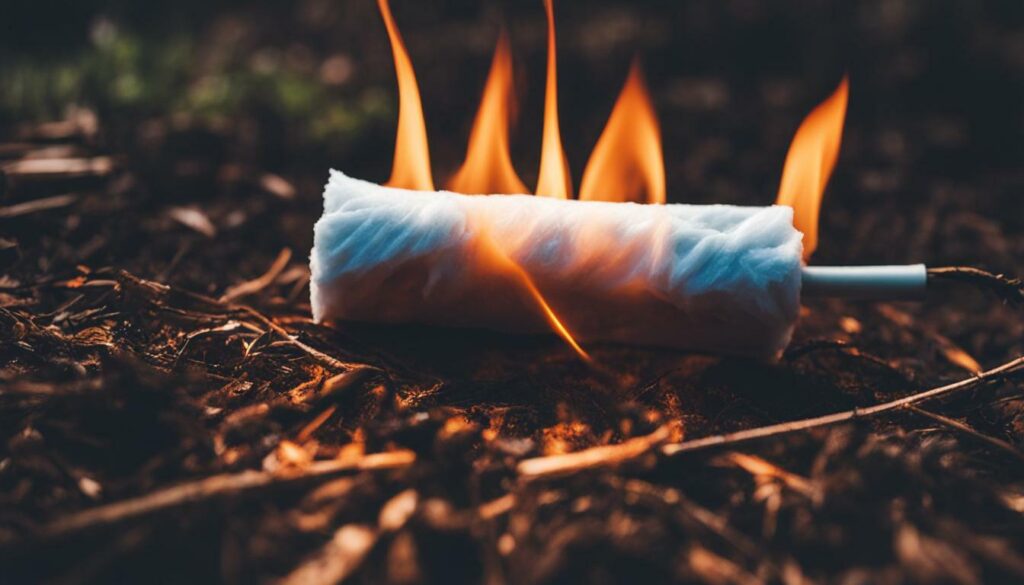

A simple black trash bag can be a valuable asset in survival situations, thanks to its versatility and durability. Whether you find yourself in a natural disaster, stranded in the wilderness, or facing an unexpected emergency, a black trash bag can serve multiple purposes to help you survive and stay prepared.
Here are some ways you can utilize a black trash bag as a survival tool:
- Carrying supplies: The strong and tear-resistant material of a black trash bag makes it ideal for carrying essential supplies. You can use it to gather food, water, clothing, and other necessities in one convenient and waterproof container.
- Providing shelter: With its large size, a black trash bag can be transformed into a makeshift shelter. By cutting openings for your head and arms, you can wear it as a poncho to protect yourself from rain or wind. Alternatively, by tying it between trees or using sticks as supports, you can create a temporary shelter.
- Collecting water: Water is crucial for survival, and a black trash bag can help you collect rainwater or dew for drinking. Simply tie the bag to a tree or place it on the ground to catch water, then use a clean cloth or water treatment tablets to purify it before consumption.
Remember, in survival situations, it’s essential to make the most of the resources available to you. A black trash bag may seem like a simple household item, but its versatility can make a significant difference in your ability to withstand and overcome challenging circumstances.
Table: Survival Uses of a Black Trash Bag
| Use | Description |
|---|---|
| Carrying supplies | Transport essentials in a waterproof container |
| Providing shelter | Create a makeshift poncho or temporary shelter |
| Collecting water | Capture rainwater or dew for drinking |
When preparing your emergency kit, consider including a black trash bag alongside other essential items. Its compact size and lightweight nature make it easy to carry, ensuring you have a survival tool that can come in handy when you need it most.
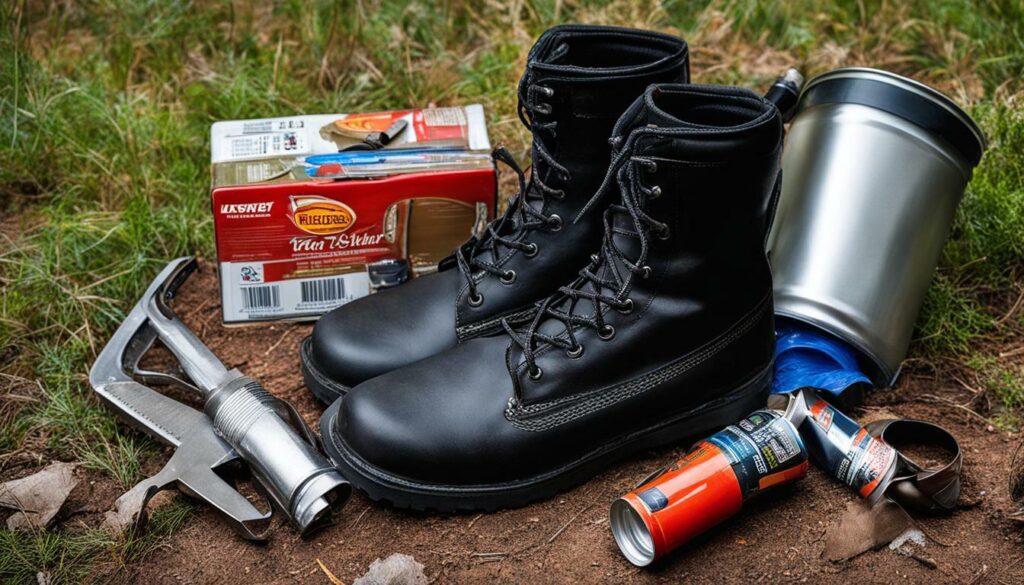

Building an Emergency Kit: Essential Items to Include
Creating a well-stocked emergency kit is essential for being prepared during survival situations. Here are some key items to include:
- Water: Store at least one gallon of water per person per day. Don’t forget to include water for pets!
- Food: Stock up on non-perishable items such as canned goods, protein bars, and dried fruits. Remember to check expiration dates regularly and rotate your stock.
- A Radio: Include a battery-powered or hand-crank radio to stay informed about news and weather updates during emergencies.
- Flashlight: Pack a reliable flashlight with extra batteries or consider a wind-up flashlight that never runs out of power.
- First Aid Kit: A well-equipped first aid kit is crucial. Include bandages, antiseptic wipes, pain relievers, and any necessary prescription medications.
Additionally, consider personalizing your emergency kit based on your individual needs. If you take prescription medications, be sure to include a supply. Don’t forget about your pets! Pack extra food, water, and any necessary supplies for them too.
| Item | Quantity |
|---|---|
| Water | 1 gallon per person per day |
| Food | 3-day supply of non-perishable items |
| Radio | Battery-powered or hand-crank |
| Flashlight | With extra batteries or wind-up |
| First Aid Kit | Bandages, antiseptic wipes, pain relievers, prescription medications |
Remember to regularly maintain your emergency kit. Check expiration dates on food and medications, replace batteries, and update any necessary documents. It’s also important to have multiple storage locations for your emergency supplies. Keep one at home, one at work, and one in your car to ensure you’re prepared no matter where you are.
By including these essential items in your emergency kit and personalizing it to your needs, you’ll be ready to handle survival situations with confidence.
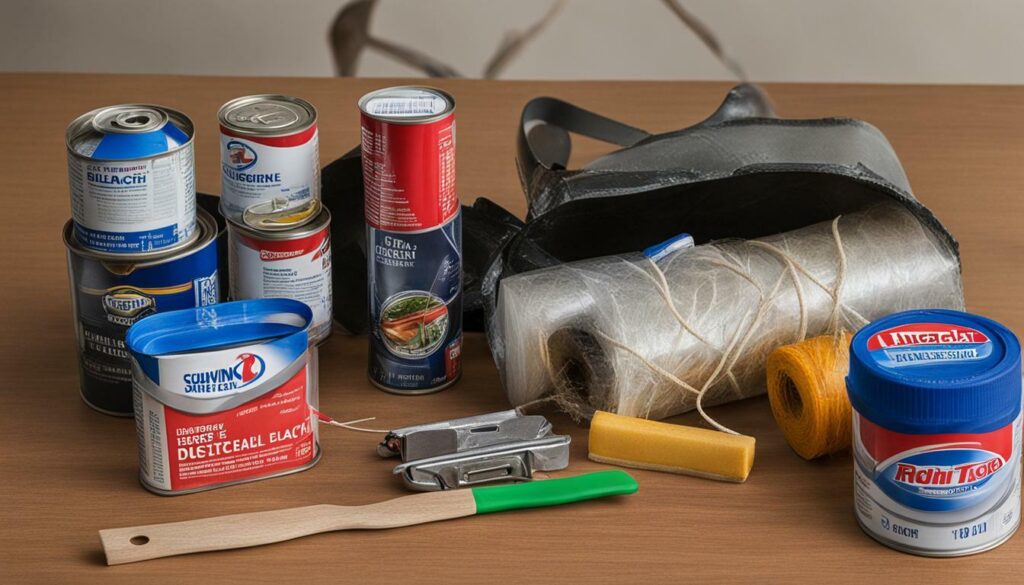

Simply having an emergency kit is not enough – regular maintenance and strategic storage locations are crucial for ensuring preparedness. Your emergency kit should be checked and updated on a regular basis to ensure that all items are in working order and have not expired. It is recommended to conduct monthly checks to replace any expired food, water, batteries, or medications. Additionally, make sure to replenish any items that have been used or are running low.
When it comes to storage, having multiple locations is essential. While keeping your emergency kit at home is important, consider having additional kits at your workplace and in your car. Emergencies can happen anywhere, and having access to essential items in different locations can make a significant difference in your preparedness.
Creating a table to organize your emergency kit supplies can be a helpful way to ensure that everything is accounted for. The table can include columns for item descriptions, quantities, expiration dates, and locations. This will allow you to easily track what needs to be replaced or replenished, as well as identify which items are stored in each location.
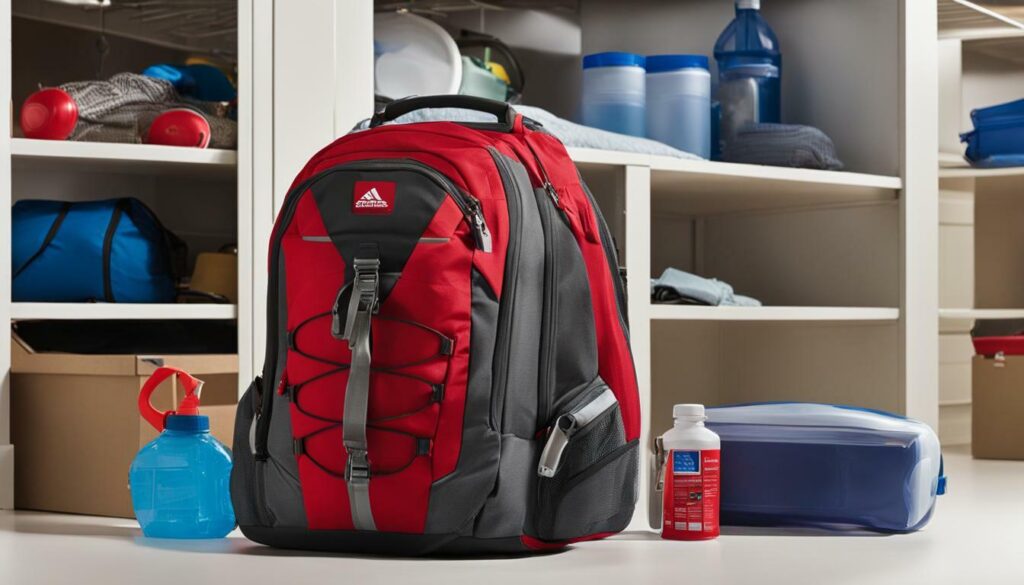

In addition to the emergency kit, it is also important to have a communication plan in place. Share the locations of your emergency kits with family members, and establish a communication method in case you are separated during an emergency. This can include designated meeting points or a prearranged method of contacting each other, such as a specific phone number or messaging app.
By regularly maintaining your emergency kit and having multiple storage locations, you can ensure that you are prepared for any unexpected situation that may arise. Being proactive and organized in your emergency preparedness efforts will give you peace of mind and the ability to effectively handle emergencies when they occur.
Conclusion
Being prepared for survival situations doesn’t always require expensive gear – everyday household items can be transformed into invaluable tools. Throughout this article, we’ve explored the versatility of various household items and how they can serve as substitutes for traditional survival gear.
Shoelaces, for example, can be repurposed as a splint, fishing line, shelter material, and even a firestarter. Chewing gum, aside from its refreshing qualities, can help ward off hunger, act as bait, or be used to start a fire. Bleach is not only useful for cleaning but can also purify water and sanitize surfaces.
Soda, aside from being a tasty beverage, can provide a quick energy boost, help with fishing, and even act as an impromptu cooking pot. Hand sanitizer serves a dual purpose of cleaning and serving as a firestarter. Tampons, beyond their intended use, can be utilized as wound dressings and for collecting water. A simple black trash bag can have multiple applications, from carrying supplies to providing shelter and collecting water.
To ensure preparedness, it is important to have an emergency kit stocked with essential items, including water, food, a radio, flashlight, and a first aid kit. Additionally, personalizing the emergency kit according to individual needs, such as prescriptions, pet supplies, and important documents, is crucial. Regularly maintaining the kit and having multiple storage locations, such as at home, work, and in the car, will further enhance preparedness and readiness for survival situations.
FAQ
Can shoelaces really be used as survival tools?
Yes, shoelaces can be repurposed for various survival purposes such as making a splint, fishing line, shelter, and even starting a fire.
How can chewing gum be helpful in survival situations?
Chewing gum can help ward off hunger and can be used as bait or a firestarter in survival situations.
What is the role of bleach in survival scenarios?
Bleach can be used to purify water and sanitize surfaces, making it essential for survival and preventing the spread of diseases.
How can soda be used as a survival tool?
Soda can provide a quick energy boost, be used for fishing, and can even act as a makeshift cooking pot in survival situations.
Can hand sanitizer serve multiple purposes in survival scenarios?
Yes, hand sanitizer can be used for cleaning purposes and can also act as a firestarter in survival situations.
How can tampons be used as survival tools?
Tampons can be used as wound dressings and can even be used to collect water in survival scenarios.
What are the various uses of a black trash bag in survival situations?
A black trash bag can be used for carrying supplies, providing shelter, and collecting water in survival scenarios.
What are the essential items to include in an emergency kit?
An emergency kit should include essential items such as water, food, a radio, flashlight, and a first aid kit. It is also important to personalize the kit based on individual needs.
How often should I maintain my emergency kit?
It is important to regularly maintain your emergency kit by checking expiration dates, restocking supplies, and ensuring everything is in working order. Aim for at least once every six months.
Where should I store my emergency kit?
It is recommended to have multiple storage locations for your emergency kit, including your home, workplace, and car, to ensure you are prepared wherever you may be.
